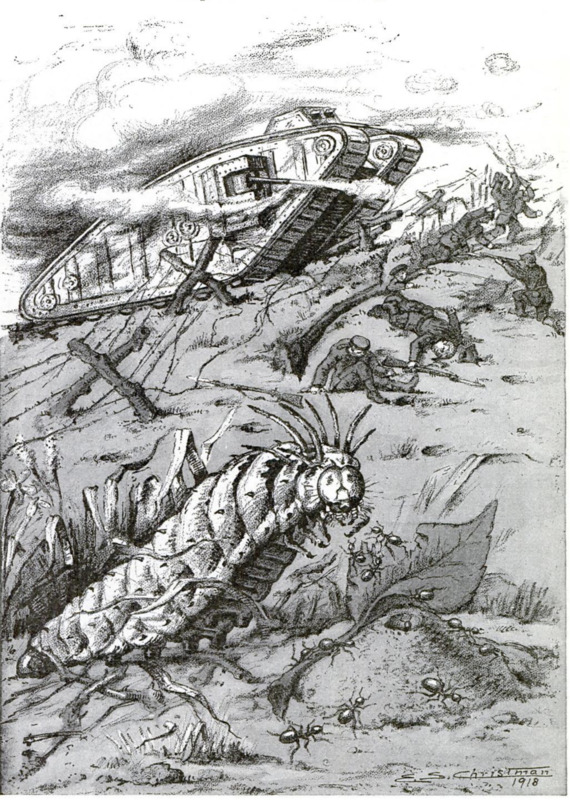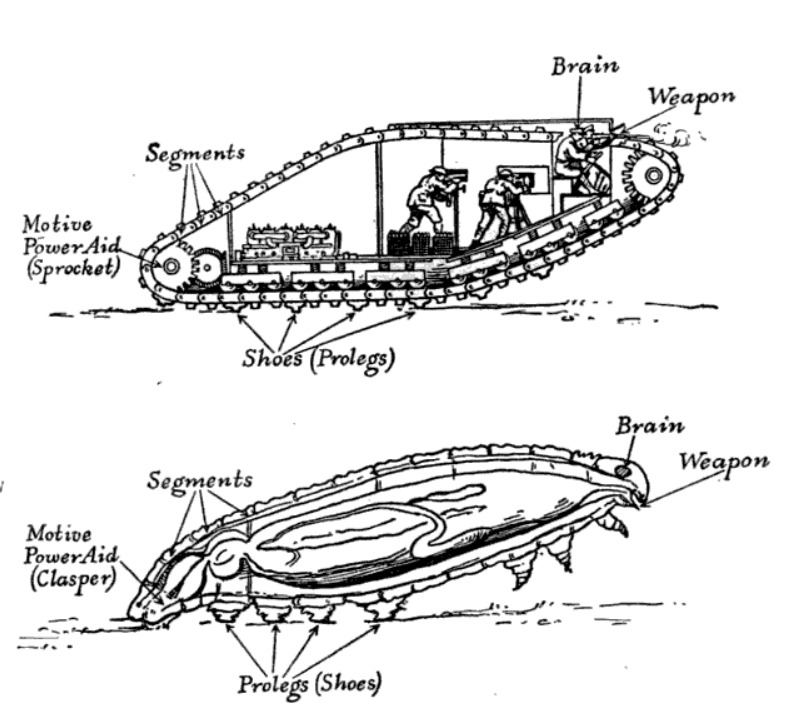-
Titolo
-
Why Tanks Are Giant Caterpillars
-
Article Title and/or Image Caption
-
Why Tanks Are Giant Caterpillars. Armor? The caterpillar has it. Traveling treads? The Caterpillar has them too. Machine guns? It has a poison squirt-gun
-
extracted text
-
THE motion of the most formidable
and terrifying of modern war ma-
chines has often been compared with
that of the lowly larva from which comes
the radiant butterfly. This famed cruiser
of the battlefields might never have been,
but for the invention of the farm trac-
tor of Benjamin Holt with its caterpillar
tread. Through the courtesy of Captain
Haiz, of the British Army, who is here
demonstrating the pride of the English
arms, the writer was permitted to spend
nearly an hour within the Britannia, and
at every point he was more and more im-
pressed with the idea that not only does
the tank resemble the caterpillar in
movement, but that there are strange
likenesses in structure, in armor, and
even in control between the two objects.
The tank is a high-powered, armored
automobile differing from the war motor-
ear in that it moves not on wheels but on
two steel belts traveling on the heavy
‘metal frames on either side of its diamond-
shaped body. The belts consist of shoes
ingeniously linked together in endless
chains. Each shoe has a flange, with
which the tank can lay a firm hold on the
ground. The belts are fitted to heavy
sprockets. The rear sprockets are con-
nected by gearing with the powerful
engine in the back of the tank. The front
sprockets are idlers over which the belts
glide. There are also wheels which rest
on the upper surfaces of the belts. At
the top of the frames are rollers over
which the belts pass. The tank is really
laying down twin tracks or a railroad
of its own.
The body of the average caterpillar
consists of thirteen segments, four of
which belong to his thorax or, dropping
into mechanical terms, his fore compart-
ment, while nine are assigned to the
abdominal section. The number _of
segments varies with the species. The
chest portion has three pairs of true
legs, so called because they are well
jointed, easily controlled and muscular.
They are protected with horny sheaths
and are in eflect armored. With these
true legs the caterpillar can steer him-
self, help himself along a twig, or seize
leaves.
The pro-legs, or false legs, appear on
at Toast five of the segments, duly paired.
In their structure they resemble the shoes
of the tank belts to some extent and they
perform the seme functions. They are
fleshy _unjointed protuberances rather
than limbs. At the bottom of each one
are minute hooks which are used auto-
matically in giving the animal a hold on
the surface he is traversing. They are
for clasping, and in fact the rear pair are
50 modified as to be called claspers.
Now, if a caterpillar could keep his pro-
legs or shoes moving over his head and
over his tail in an endless chain arrange-
‘ment, his resemblance to the tank as far
as the locomotion details are concerned
would be perfect.
Some of the caterpillars have such a
rapid, undulating movement, that it ia
hard at first to analyze its elements. The
caterpillar actually walks by extending
and contracting the fleshy segments of
his body, the power being transmitted
‘mostly to his pro-legs.
‘Any one who has seen the fuzzy larvae
of the tussock moth going up a tree trunk
‘wil realize that the caterpillar is happy at
any angle. The same principle of construc-
tion illustrated in that insect permits the
tank almost to stand on end without los-
ing balance.
For the sake of simplicity, the wheels
at the rear of the tank by which it was
once steered have been discarded and
the direction is given by running the two
belts at different speeds. The landship
is rudderless. The caterpillar can twist
his segments at the jointures.
The observation facilities and guide
centres of both are in their forward com-
partments. The commander of a tank
and the driver sit well forward in the
Juggernaut, looking out of very narrow
slits. When it is necessary to close the
slits on account of rifle fire, the pilot
gropes his way as best he may. The
captain or lieutenant in command is the
brains of the steel-clad caterpillar.
Caterpillars have fairly active brainsand
a good workable ganglia, or nerve center.
On either side of the head they have small,
shining eyes inrows. They also get good
information about the nature of the
surface over
which they are
passing by low-
ering delicate
filaments or
sense organs
known as pa-
pill.
The British
tank is a terror
to the Teuton
infantry as it
starts relent-
lessly over No
Man's Land,’
crushing every-
thing within
its reach and
mowing down
the enemy. It
brushes aside
wire entangle-
ments, shatters
dugouts and
forts of reinforced concrete and slays
cowering wretches in the trenches whose
cries for mercy the men in the car of
death cannot hear. What the tank is to
modern battle, the caterpillar may well
be in the wars of the insect world.
Imagine what a vision of frightfulness
that hideous specimen of the larval state,
the hickory-horned devil, would be to
the human race, if he were enlarged to
tank size, approximately eight feet wide
and twenty-eight feet long! What a sight
to make men’s knees shake with fear,
with his waving antenne, his fierce and
gleaming jaws, his towering horns, his
beady eyes, and his ponderous bulk! He
would ignore all obstacles as he went
trampling and devouring over the plain,
his vertical mouth opening and shutting
meanwhile like a ponderous valve.
In the realm of twigs and leaves, the
ery “The Caterpillars are coming!” must
mean as much as the alarm “The Tanks!
The Tanks!” means to the Germans. The
caterpillar is not the inoffensive slug
which he often seems to be as we look
down upon him as he bestirs himself
across some woodland walk. His hide is
very thick, and underneath it is a heavy
layer of fat. The doughty warrior ants
coming out with their nippers to assail
him, do not worry him much. Up goes
the tank of the world underfoot, and
down he comes
with a swing
of the forward
part of his body
and a group of
his enemies are
crushed to
extinction.
Several varie-
ties of cater
pillars have
very effective
weapons of of-
fense. The spe-
cies from which
comes the swal-
low-tail butter-
fly mounts a
rapid-fire
poison-gas gun.
‘When he ishard
pressed by his
enemies he will
project from his
head a tube which looks not unlike the
barrel of a Lewis machine-gun, and dis-
charge an odor so offensive that insects
‘within scent of it curl up and die.
The camouflage of tanks and cater-
pillars is effective always. “Old Crusty”
at the western front and “Old Crawly,”
of the garden both resort to disguise.
The tank is often painted the hue of the
mire; the caterpillar assumes the tone of
the soil.
There scarcely seems a characteristic,
therefore, either of the fuzzy denizens of
the foliage or of the monster military
mechanisms which may turn the tide
of this war, which does not reveal that,
after all, the terrors of the terrain are
caterpillars titanic.
It seems, after all, as though “there's
nothing new under the sun.” We copy
the fish for submarines, the birds for
airplanes, and now the tank is just a
glorified caterpillar.
-
Autore secondario
-
John Walker Harrington (writer)
-
Lingua
-
eng
-
Data di rilascio
-
1918-04
-
pagine
-
556-558
-
Diritti
-
Public Domain (Google digitized)
-
Archived by
-
Filippo Valle
-
Alberto Bordignon (Supervisor)




